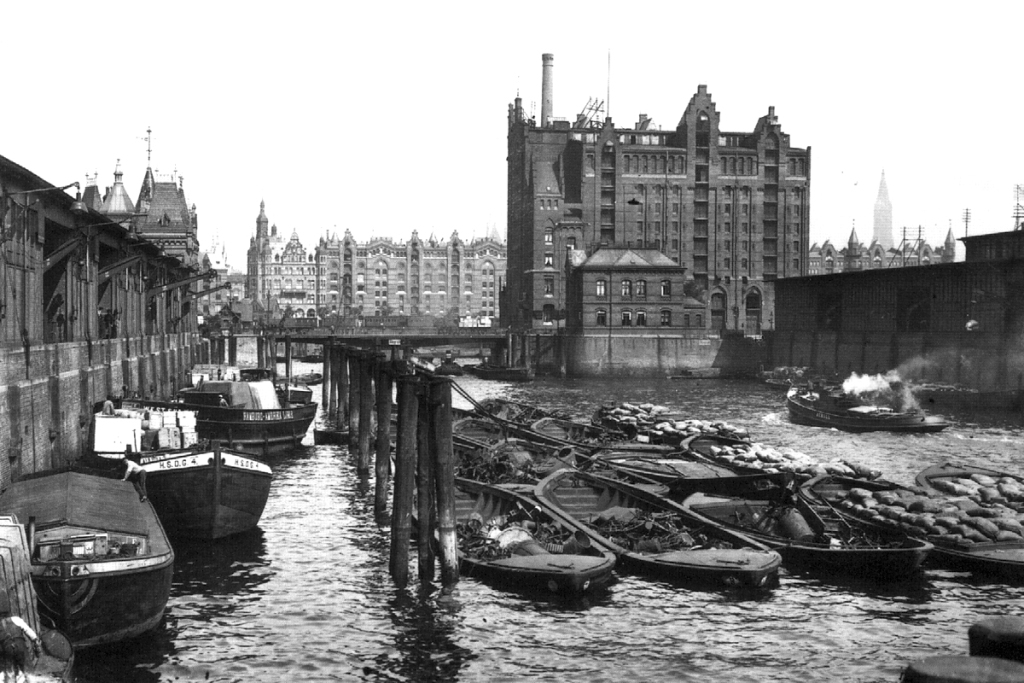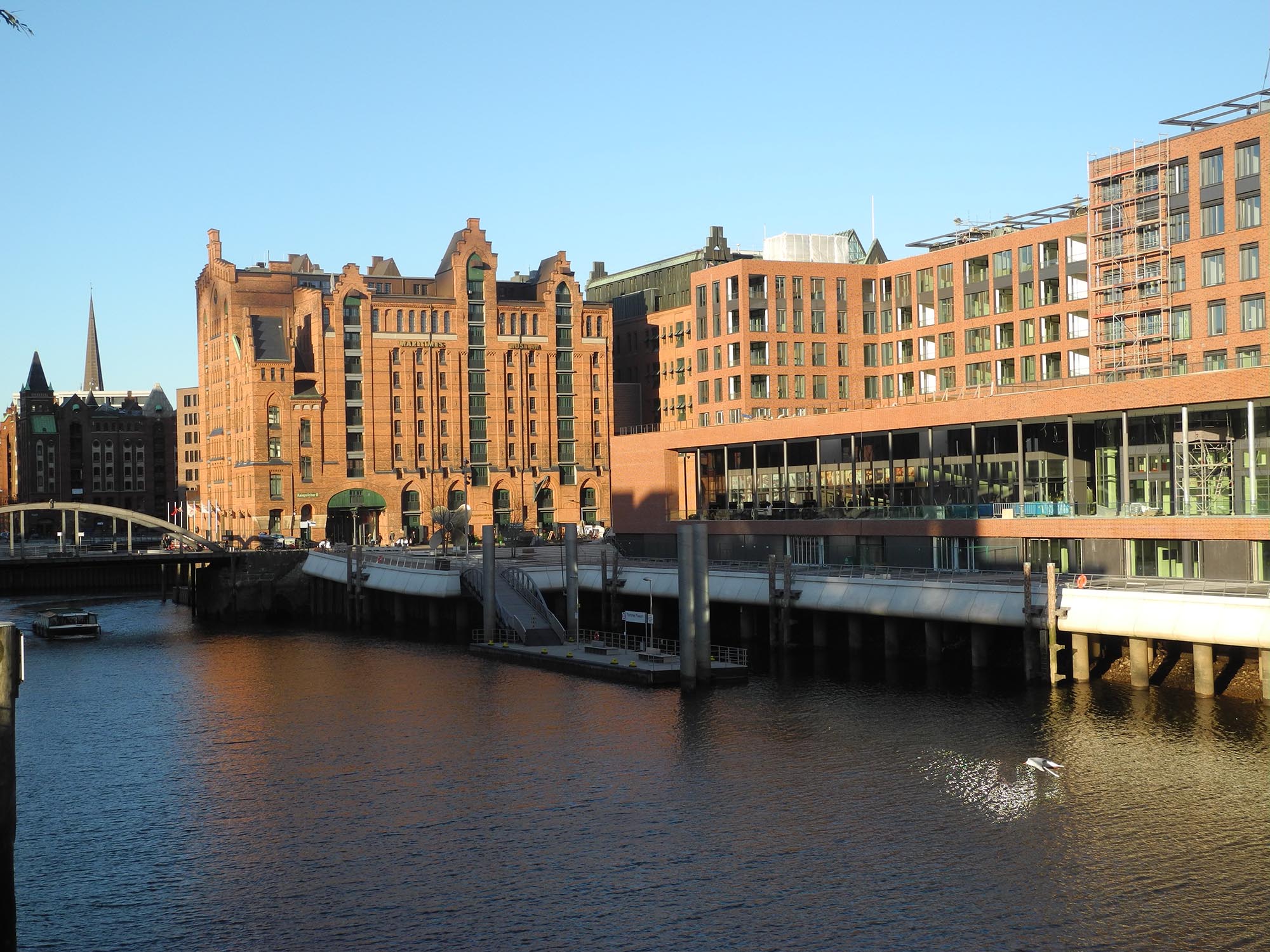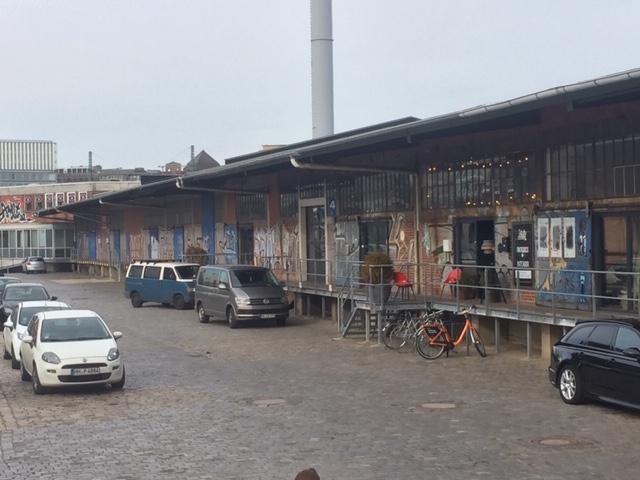In the context of the worldwide reconstruction of fallow harbor and shoreline zones, special types of buildings have gained new meaning: storage complexes. In all seaport cities such buildings exist in different typologies and are located close to the city center and usually built with river and water nearby to store, secure and possibly refine goods. With the industrialization and expansion of trade, the construction of storage buildings became more important, new construction methods were developed and larger storage complexes emerged. However, with the introduction of containerized cargo handling since the 1970s, the storage buildings have become redundant. The container could also serve as a transport and storage container. For (largely automated) containerized cargo handling large land areas and free quay edges were required. Storage remained unused, decayed, or were demolished immediately. A future as a warehouse for storage buildings will therefore be possible worldwide only in a few exceptional cases.
Some of the buildings were listed buildings, and many of the buildings were in municipal or state ownership. Repairs and conversions of storage facilities for other uses were cost-intensive, and the often-deep construction of the storage facilities made it difficult to adequately illuminate and ventilate. As utility buildings they were granted little attention, care and entertainment. In recent years, however, the spirit of the times has recognized the importance of secular buildings and, as traditional islands, they form reference points for a staged maritime culture, which, framed by museum ships and old cranes, is intended to depict an authentic harbor ambience for locals and tourists.
Warehouse B used for storage at the end of the 19th century. (Landesbildstelle Hamburg)
Storage buildings are now regarded as great testimonials of the maritime heritage and form unique selling points for city marketing. Formerly sober functional buildings can mutate into spectacular architectures that merge old and new. Reuse opportunities seem to be unlimited, and brokerage demand for investment objects is meeting with a big response. Storage buildings are “in” and selective parts of the port are being “exhibited” there for the leisure society. The reuse opens up various options – as temporary use and, if necessary, taking into account the protection of historical monuments – for museums, culture, offices, restaurants, hotels, showrooms, galleries and mixed uses. It remains to be evaluated on a case-by-case basis whether it has been possible to preserve monument protection and authenticity, whether it is dominated by plastering and nostalgia, or whether it is “only” a matter of historically declared structures.
The warehouses are often embedded and hidden in meanwhile revitalized waterfronts with dense high-rise buildings and draw a positive, narrative charged image of harbor and harbor work, which includes the myth of the exotic. The architectural heritage (“tangible”) of orchestras, music, film and literature (“intangible”) is orchestrated and used as part of city marketing for the ideologization of the maritime.
Former Warehouse B, now International Maritime Museum Hamburg. (Dirk Schubert)
Against the background of industrialization and the rapid increase and internationalization of trade, new challenges for the handling of goods, storage and thus larger storage complexes have arisen. This resulted in special infrastructures that holistically involved the process of goods handling, storage, processing, customs clearance and, finally, onward transport. As the example of Hamburg demonstrates, since the beginning of the 19th century, these logistical complexes have been integral parts of the complex organization of cargo handling and tailored to the specific requirements of trade in seaport cities and the respective specialization of goods.
Various types of storage, arranged parallel to the shore or gabled, are to be distinguished: transit storage, open sheds, or hall-like structures were used only before further loading and the protection of the weather. The medium- to long-term storage tanks, on the other hand, were generally built as multi-storey, solid structures constructed of wood, cast iron, reinforced concrete or steel, which were flexible in many ways but often designed for the storage of special goods groups (Schubert, 2018). The storage in public or private storage took place mainly for customs reasons. The duties were only to be paid when goods were exported. The free ports (“free warehouse”) were thus almost extraterritorial “foreign countries”. For the term storage other term also used the term warehouses, packing houses, department stores or Entrepots.
The warehouse district, “City of Warehouses” (“Speicherstadt”) in Hamburg is probably the world’s largest storage complex (about 21 ha). The ensemble of red brick for duty-free storage was built after 1885 in several sections as a free zone. The area, the Wandrahminsel, was inhabited before the construction of the Speicherstadt and about 20,000 people had to give way and seek a new place to stay. The Speicherstadt was a “city in the city” with canals, cranes, power station, fire brigade, post office, bank, customs office, canteens for dockers and railway connection (Hesse, 2012). The free port was thus excluded from the city. The area was fenced and accessible only by means of (customs) controls. During the Second World War, many stores were (partially) destroyed. New buildings were carefully inserted in similar cubature and brick architecture. New users like carpet retailers took advantage of low rental rates, followed by cultural institutions, creative people, offices and fashion companies. The buildings were gradually repaired, gradually reused and prepared for new uses. With the beginning of containerization, the storage of goods in storage has become superfluous. The vacancy was initially used by carpet dealers, who offered the rental-priced storage areas in the free port area. Gradually, other industry sectors also discovered the benefits of the location and the qualities of the buildings and a gradual conversion began.
Creative and cultural quarter (Oberhafenquartier) 2019. (Dirk Schubert)
In 2011, the free port status for Hamburg and also for the Speicherstadt was lifted under EU-law. Speicherstadt is owned by the City of Hamburg and is managed by Hamburger Hafen und Logistik AG (HHLA). The entire Speicherstadt was already listed and was declared World Heritage Site in 2014 with the Chilehaus and the historic office district “Kontorhausviertel” by UNESCO. UNESCO has thus recognized the exceptionally high urban planning, design and conceptual format of the project. It does not lack a certain irony that a radical land transformation more than a century ago for the interests of the trade receives this award (Seemann, 2017: 153).
Meanwhile most spectacular is the municipal warehouse A – “Kaiserspeicher” (destroyed during the war and rebuilt in 1963) which has since been converted to the Elbphilharmonie, two concert halls, a hotel, flats, restaurants and parking. The warehouse B became the International Maritime Museum Hamburg (IMMH). Meanwhile more museums were established as the German Costums Museum, Hamburg Dungeon, Miniatur Wunderland (a model railway) and the Speicherstadt Museum. Even hotels, restaurants and coffee roasters are now reviving the formerly brittle charm of the warehouse district.
The conversion of listed warehouse buildings is complex, expensive and technically complicated. The Speicherstadt is also located in the flood-prone area and in floods basements and ground floors (partially) can be flooded. The building construction and depth of the storage buildings make it difficult for living and working a sufficiently good exposure inside. In addition, regulations of fire protection must be observed. Nevertheless, Hamburger Hafen und Logistik AG (HHLA) as the owner and administrator of the properties has found appropriate step-by-step, block and building-based strategies for maintaining and re-letting.
A rather exotic example is the preservation of Oberhafenkantine, a former canteen for dockers, built in 1925 in an expressionistic brick architecture. After a flood, the building partially sagged, became in a banking and threatened to collapse. In 2000, the building was listed as a historic monument, the decorated restaurant became a tourist attraction and a kind of entrance gate for the current hip Oberhafenquartier at the north-eastern edge of the HafenCity.
Oberhafenkantine, Former canteen for dockers. (Dirk Schubert)
The importance of the built environment as an important testimony of maritime history has been recognized and used as an identity-forming manifestation for the transformation of the waterfront. After a period of neglecting maritime heritage (“de-marinification”), all testimonies of local maritime traditions (“re-maritimication”) are nostalgically staged in seaport cities and used as distinguishing features for image building and positive city marketing. Even though the intangible cultural heritage and the “soft values” have meanwhile gained in importance, monuments and secular buildings such as reservoirs remain important architectural witnesses of maritime history. Although – or precisely because – the local economy in seaport cities is becoming increasingly diversified and attempts to compensate for the processes of deindustrialisation have often failed, the maritime character is deliberately cultivated and specially staged. Unlike the modern “lighthouses” of star architects in seaport cities, the storage buildings document the historical-maritime narrative and promote identity creation.
However, only isolated (often converted) and alienated storage buildings have been preserved, which at the same time document local architectural evidence and symbolization of global trade activities. The decaying storage is not useless, but can form the nucleus for new neighborhoods on the water. The staged “cultural experiences” in “trendy” building ensembles and storage complexes, safe and clean, can only portray a selective representation of maritime history. But there are plenty of examples that show how history and heritage can be combined with reuse and revaluation and the risk of commercialization and folklorization avoided. Not preserving, revitalizing and focusing on authenticity as well as a concept, which works out the site specificity, it is necessary to implement it not museification and maritime folklore (“SHE” – seafood, history, entertainment). The dilemma between sustainable tourism (cruise shipping!), preservation and authenticity of storage buildings as well as high densities, gentrification and profitable uses on the waterfront becomes a squaring of the district.
The conversion of the warehouse district in Hamburg demonstrates a careful, incremental, step-by-step transformation. It verifies options of plan-led restructuring and a shift from preservation of buildings to cultural heritage.
References
Hesse, Frank Pieter (ed.), Stadtentwicklung zur Moderne. Die Entstehung großstädtischer Hafen – und Bürohausquartiere (ICOMOS), Berlin 2012.
Schubert, Dirk, Ikonen des Handels. Identitätsstiftende Speichergebäude in Seehafenstädten zwischen Erhalt und Kommerz, in: Die alte Stadt – Forum Stadt 4/2019, pp. 344-370.
Seemann, Agnes (ed.), UNESCO Welterbe. Speicherstadt und Kontorhausvietrel im Chilehaus, Arbeitshefte zur Denkmalpflege in Hamburg Nr. 29, Berlin 2017.
Head Image: Map of the World-Heritage area (red) with bufferzone (grey), HafenCity Hamburg south of it, along the river Elbe. (Seemann, 2018, p. 50)



